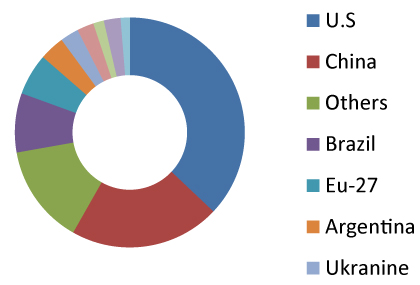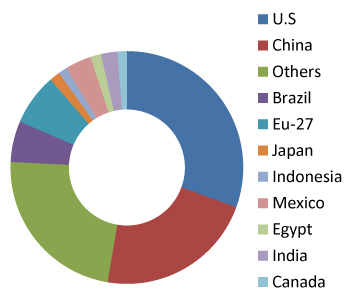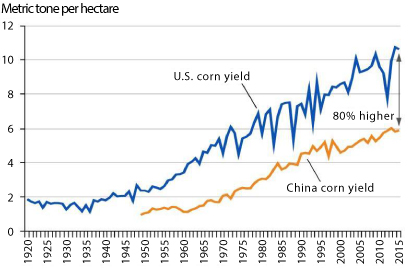Journal Name: Scholar Journal of Applied Sciences and Research
Article Type: Case Study
Received date: 19 January, 2019
Accepted date: 15 February, 2019
Published date: 22 February, 2019
Citation: Huma B, Hussain M, Ning C, Yuesuo Y (2019) Human Benefits from Maize. Sch J Appl Sci Res Vol: 2, Issu: 2 (04-07).
Copyright: © 2019 Huma B. This is an open-access article distributed under the terms of the Creative Commons Attribution License, which permits unrestricted use, distribution, and reproduction in any medium, provided the original author and source are credited.
Abstract
Maize is one of the most popular oldest and powerful cereals crops, which is popularly used for food, fodder and also for medical purpose in the world. More than 3,500 uses of corn products are nominated. It covers health related issues due to presence of nutritional values. Its helps as Analgesic, Astringent, Anti-allergic, Emollient, again skin rashes, against store throat, Anti angina, Anti-hypertensive, Against biliousness, Anti lithiasis, Anti diarrheal, Urinary disorders including dysuria, cystitis, urethritis, nocturnal enuresis and etc. It also good source of vitamins A, B, E and many minerals It has reduced hypertension and prevented neural-tube defects at birth. The aim o f this article is to revise maize and maize products.
Keywords
Maize, Production, World’s economy, Food, Cereal, Health.
Abstract
Maize is one of the most popular oldest and powerful cereals crops, which is popularly used for food, fodder and also for medical purpose in the world. More than 3,500 uses of corn products are nominated. It covers health related issues due to presence of nutritional values. Its helps as Analgesic, Astringent, Anti-allergic, Emollient, again skin rashes, against store throat, Anti angina, Anti-hypertensive, Against biliousness, Anti lithiasis, Anti diarrheal, Urinary disorders including dysuria, cystitis, urethritis, nocturnal enuresis and etc. It also good source of vitamins A, B, E and many minerals It has reduced hypertension and prevented neural-tube defects at birth. The aim o f this article is to revise maize and maize products.
Keywords
Maize, Production, World’s economy, Food, Cereal, Health.
Introduction
Maize (Zea mays L.) is one of the most important cereal crops used in the human diet in large parts of the world and it is an important feed component for livestock. In terms of total world production, maize on average over the last five years out ranked paddy rice (Oryza sativa) and wheat (Triticum aestivum).
Global production exceeds 600 metric tons [1], with about 60% produced in the developed countries, particularly by the United States of America, China produces 27% of the world’s maize and the rest is grown in countries of Africa, Latin America, and southern Asia with a large proportion being produced in the tropics and subtropics. World total maize consumption and production of 2016-17 are shown in graphically below. Total world maize production is 40,861 million bushels, while country wise production of 2016-2017 is given the graph shown in Figure 1. As this graph showed that after U.S, China is largest maize production with 8,643 million bushels while production of maize from Brazil, Eu-27, Argentina, India is 3405, 1437 and 965 respectively.
Figure 1: Country wise maize production of 2016-2017.
Total world maize consumption is 40,429 million bushels, while country wise production of 2016-2017 is given the graph shown in Figure 2. U.S is largest maize consumption with 12,360 while China is second largest maize consumption 8937 million bushels.
Figure 2: Country wise maize consumption of 2016-2017.
By the early 20th century, maize had become one of China’s major crops. The maize area expanded to 10 million ha, approximately 12% of total cultivated area, between 1900 and 1930. The area sown to maize continued to increase rapidly during subsequent periods; in 22 provinces (not including northeastern China and Inner Mongolia) it increased by 20% between the periods 1937-1945 and 1946-1949 [2].
Next to rice, wheat, and millet, maize was the fourth most cultivated cereal crop in China in 1949, when the People’s Republic of China was established. By 1951, maize had exceeded millet in terms of sown area, and maize took its place as the third most cultivated cereal crop in China. Maize area continued to increase substantially during the 1950s, as yields increased. In recent years, however, trends in maize area and production have exhibited higher levels of variability.
Graphic representation of China’s corn yield has risen steadily over past five decades have been shown in Figure 3. Maize grain has greater nutritional value as it contains 72% starch, 10% protein, 4.8% oil, 8.5% fiber, 3.0% sugar and 1.7% ash [3].
Figure 3: China’s corn yield data over past five decades.
Maize has various health benefits. The B-complex vitamins in maize are good for skin, hair, heart, brain, and proper digestion. They also prevent the symptoms of rheumatism because they are believed to improve the joint motility. The presence of vitamins A, C, and K together with beta-carotene and selenium helps to improve the functioning of thyroid gland and immune system. Potassium is a major nutrient present in maize which has diuretic properties. Maize silk has many benefits associated with it. In many countries of the world such as India, China, Spain, France and Greece it is used to treat kidney stones, urinary tract infections, jaundice, and fluid retention. It also has a potential to improve blood pressure, support liver functioning, and produce bile. It acts as a good emollient for wounds, swelling, and ulcers. Decoction of silk, roots, and leaves are used for bladder problems, nausea, and vomiting, while decoction of cob is used for stomach complaints [4].
Nutritional importance
Maize grains have great nutritional value as they contain 72% starch, 10% protein, 4.8% oil, 8.5% fibre, 3.0% sugar and 1.7% ash [3]. Zea mays is the most important cereal fodder and grain crop under both irrigated and rainfed agricultural systems in the semi-arid and arid tropics [5].
Economical Importance
Maize is very important because of good source of minerals, vitamins, fiber and oil present in maize (rich in embryo). This oil is used for cooking and soap making companies. Maize starch is famous in pharmaceutical Industries as diluents and also used in cosmetics. Its seeds used to make alcohol while stem used for paper manufacturing. Small scale farmers are engaged with maize forming, because of its highly nutritional values and affordable source of vitamins and minerals for people living in rural areas.
Traditional uses
- Analgesic
- Astringent
- Anti-allergic
- Emollient
- Again skin rashes
- Against store thorat
- Anti angina
- Anti hypertensive
- Against biliousness
- Anti-lithiasis
- Anti diarrheal
- Urinary disorders including dysuria, cystitis, urethritis, nocturnal enuresis
- Anti-prostatitis
- Anti tumor
- Anti dysentery
- Anti gonorrheal
- Medical
- Diuresis and kaliuresis effect
- Diuretic
Pharmaceutical uses
- Maize has diuretic properties because of major nutrient (potassium) [4] and in water-loaded conscious rats, maize silk exhibited as a diuretic and kaliuretic effect [6].
- Major diseases likes, urinary tract infections and kidney store are going to be treated with maize silk in many countries like Greece, France and Spain. It is frequently used in china for jaundice, and fluid retention. Corn silk improves blood pressure and support liver functioning as well as producing bile [4].
- Maize oil have linoleic acid, a fatty acid which has properties of controlling of blood pressure by regulating blood cholesterol level and help in prevention of cardiovascular maladies [7-9].
- Oil of maize is used for treating dandruff.
- Maize is good source of carotenoids, phenolic and phytosterols compounds [10-12]. Which are known as Phytochemicals. These are bioactive compounds exists in plant help in reducing major chronic diseases in human beings [13].
Maize Types and Uses
A number of maize types can be discerned on the basis of endoperm, color and kernel composition [14-16].
Sweetcorn also called sweet corn, sugar corn and pole corn is a cereal with a high sugar content. Its sweetness is because of recessive mutation in metabolism which prevents its transformation sugar to starch. It is grown in green ears and harvest at approximately 18 to 20 days post pollination when kernel moisture is almost 70%. It is mostly grown in USA.
Pod Corn is also type of wild maize, is mutant that form from leaves around each kernel and is not wild ancestor of maize. It is mostly group for research purpose to trace the genetic root of corn. Each of kernels is enclosed in a glumes or husk. It is grown on small scale and used as snack food. Its taxonomic relation with other types is still under discussion [17].
Flour corn has soft starchy endosperm and a thin pericarp [18]. It is primarily used to make corn flour and resemblance with flint maize and predominately grown in Andean region. In South American its use is in preparation of beer.
Dent maize its name is assign to it because of small indentation i.e. dent at each kernel. It is higher concentration of soft starch, and mostly grown in USA. It is used in food manufacturing as the base ingredient for cornmeal flour (used in the baking of cornbread), corn chips, tortillas and shells. It has great importance and account almost 95% of all maize products.
Flint maize is also known as Indian corn, calico corn. It has high percent of hard endosperm around a small soft center. It is found in multi Colors and mostly grown in Latin American and Europe for food, and it become mature earlier then other varieties. It has more resistant to fungi and insects due to less moisture absorbing capacity, so it can store durably than other varieties.
Waxy maize Kernel contain almost all amlopection as their starch rather than normal 70% amylopection and 30% amylase. Waxy corn on the cob is popular in China and Southeast Asia. The exact history of waxy maize is unknown. The first mentions of it were found in the archives of the U.S. Department of Agriculture (USDA).
Conclusion
Maize has worldwide importance due to its nutritional value, it is not only used for food but its waste also has unique importance in industries and for animals, so based on such benefits, it is suggested to make it part of daily diet and also research such focuses on it more to explore new advantages of it.
There are no references





